Ah, pilau rice. Doesn't that sound like a terrifying thing to try and cook yourself? Fear not, dear reader, because this fool-proof recipe really does work. By adding a layer of cooking foil between the pan and its lid, you'll create a tight seal that ensures your rice is cooked to perfection.
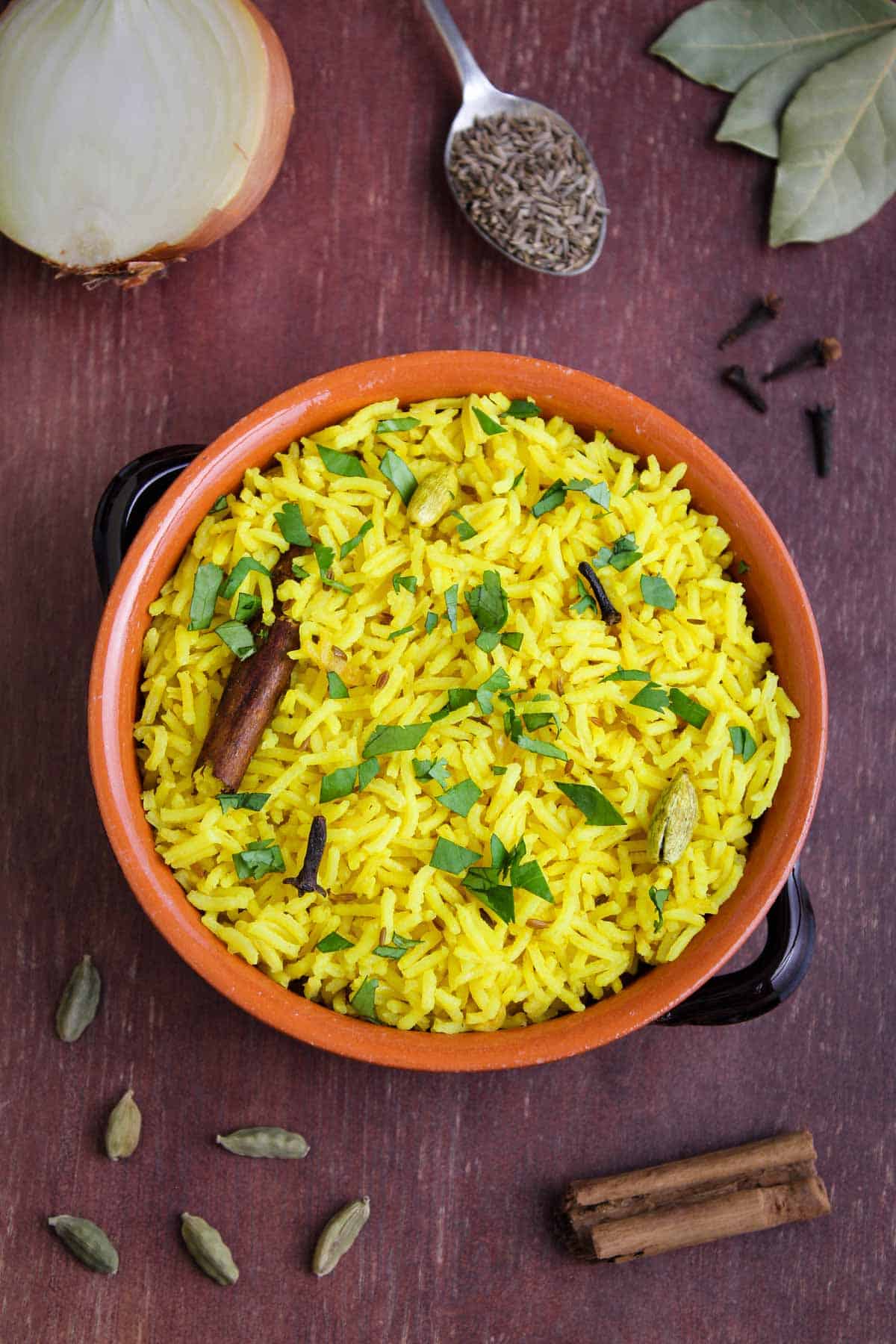
A great alternative to regular boiled or steamed rice, this pilau rice uses whole spices and fried onions to create a flavourful side dish that's vegan, dairy-free, and gluten-free.
With a striking yellow colour from the ground turmeric, you'll have light and fluffy grains that are just waiting to soak up whatever curry you want to serve it with (plenty of suggestions below).
For similar one-pot recipe ideas, check out this vegan biryani with chickpeas, vegan mushroom biryani, and hearty vegan jambalaya.
I create new content every single week. Subscribe to keep in touch and get a free download of The Vegan Kitchen – My Top 10 Tips.
What is pilau?
Pilau – also known as pilaf – is a rice or wheat dish that's popular around the globe. It's usually cooked in a flavourful broth with spices, as well as other ingredients ranging from vegetables to meat or fish.
Pilau rice is a popular accompaniment to curry dishes, served as a side rather than being a rice-based main dish. Here in the UK, you're pretty much guaranteed to find it in any Indian or South Asian restaurant or takeaway.
See also this recipe for Turkish-style bulgur pilav (made with bulgur wheat). 👇
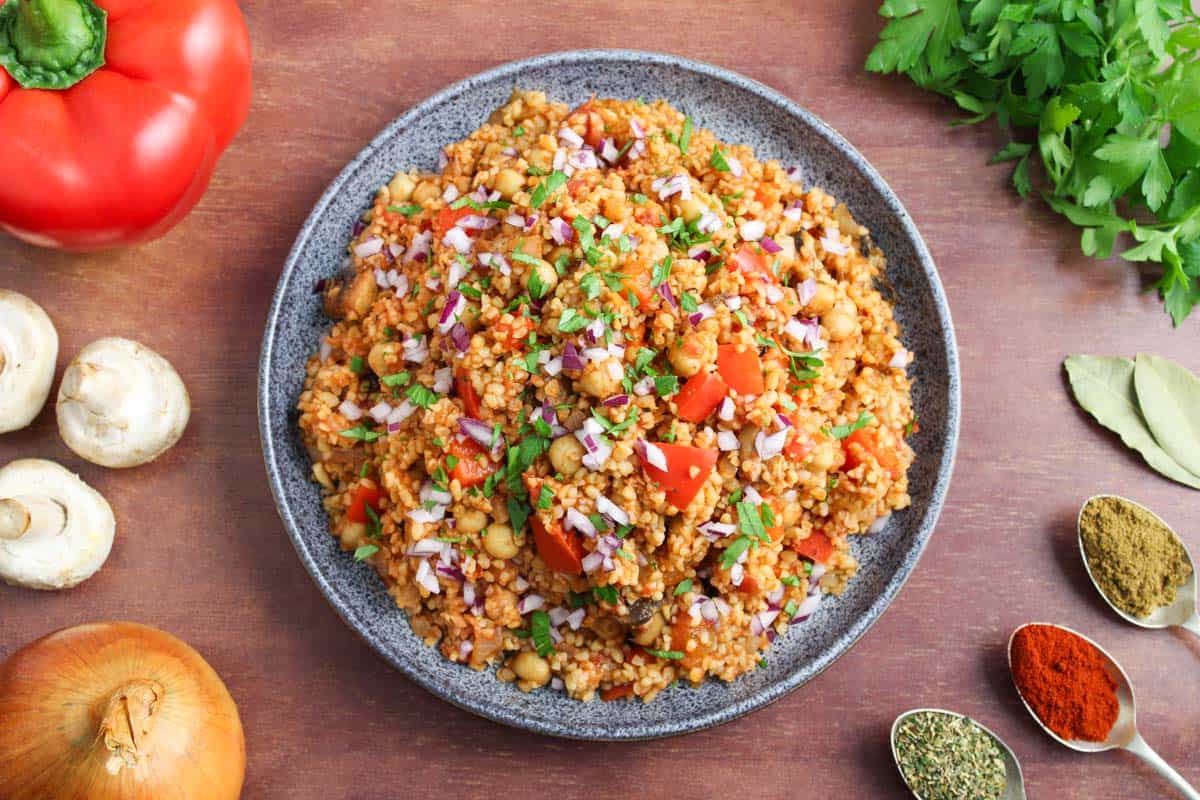
Is pilau rice vegan?
Although pilau rice is very easy to veganise, many recipes will often include butter or ghee (clarified butter). To make this rice dish vegan, simply omit the butter and stick to cooking oil instead.
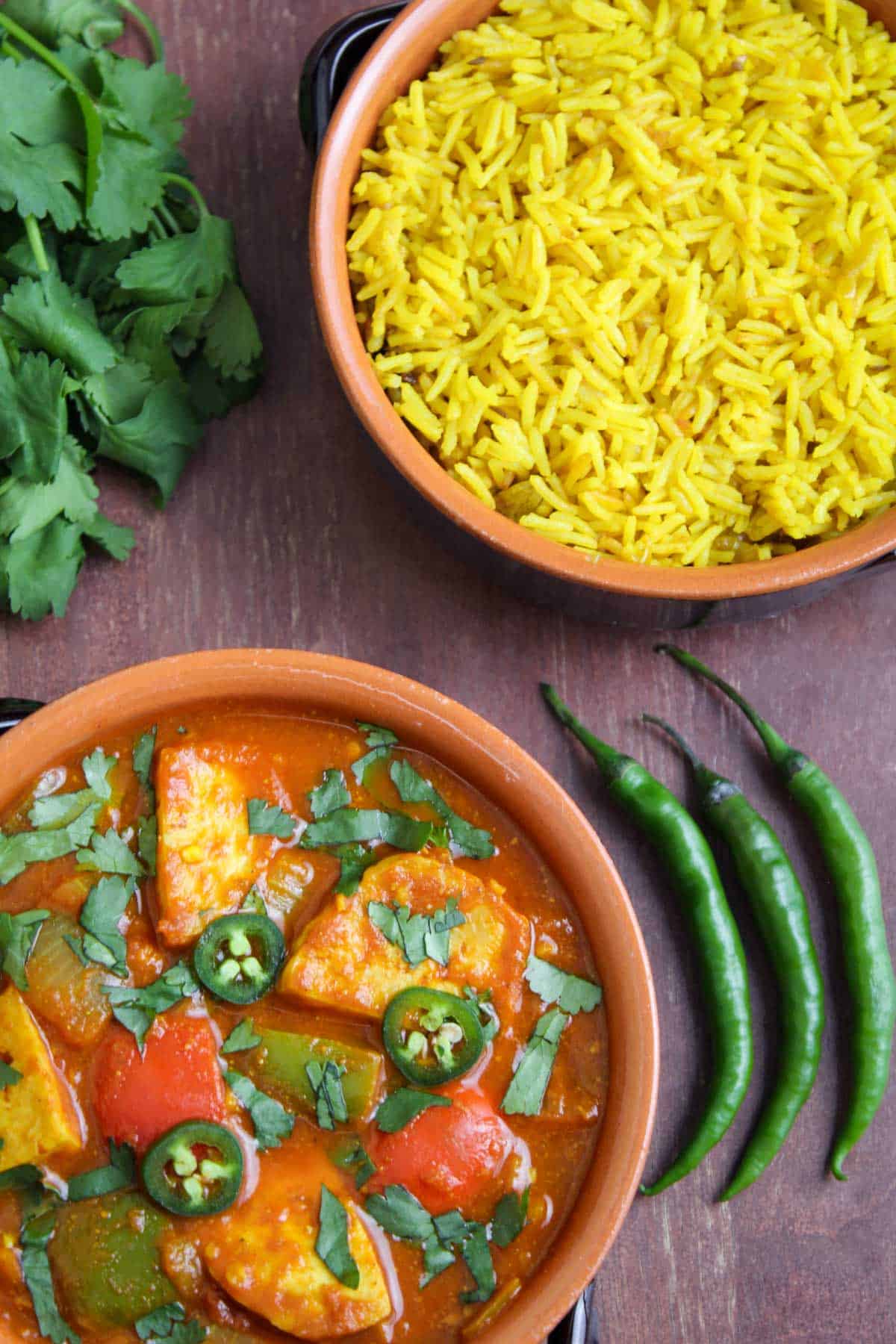
Which rice is best?
The best rice to use for pilau is white basmati rice. You could also use long-grain white rice, but basmati is preferable with its fragrant, nutty flavour.
Either way, be sure to use white rice and not brown. Brown rice takes longer to cook and you won't get the same vibrant yellow colour.
Whatever you do, don't use an 'easy-cook' variety, short-grain variety, or risotto rice for this recipe.
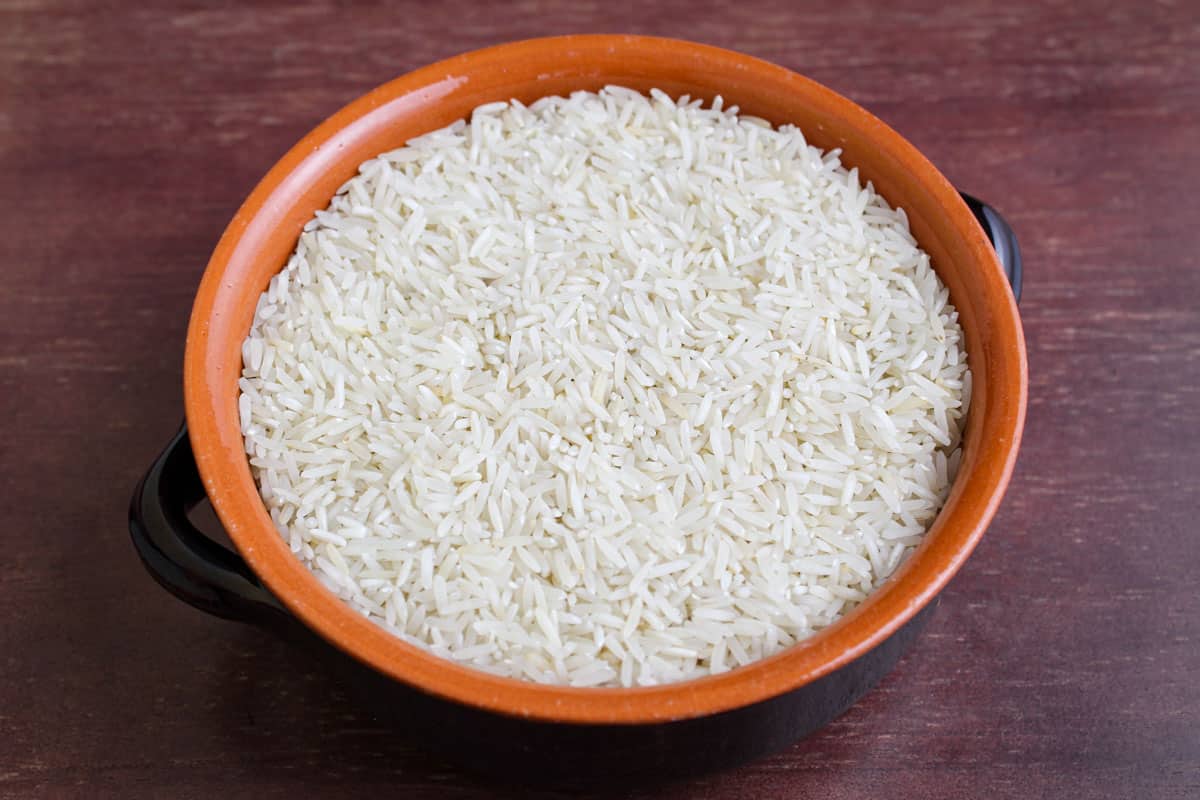
Rice to water ratio
When I boil rice, I usually do it in plenty of water until cooked then drain it and serve. It works every time, and I don't need to rely on some magical ratio for success.
While that's fine for plain boiled rice, the water ratio is actually an important factor when it comes to pilau rice. This is because there are lots of flavours involved, and you don't just want to drain those away when you're finished cooking.
After testing this recipe many times, I've decided that the ideal ratio is 1 part rice to slightly less than 2 parts boiled liquid. In this recipe, that means 2 cups of rice to 3½ cups boiling water or stock.
What do you mean, 'cups'?
If you're in the UK, you'll know that cups are not a measurement we're used to. But to get your ratios right here, the easiest thing is to literally use a drinking cup or mug out of the cupboard if you don't have standard US measuring cups (240 ml volume).
These may work out slightly larger compared to the gram and ml amounts stated below, but you can always store extra rice in the fridge or freezer. As long as you use the same vessel, the golden ratio for this recipe is 2 level cups rice to 3½ level cups hot liquid.
Whatever your vessel of choice, just make sure it's heat-proof as you'll be measuring water that has already been boiled.
What you'll need
Pilau rice recipes vary considerably in terms of spices and flavourings, but here's what I've gone for:
- Basmati rice for its delicious, nutty flavour
- Onion to provide an aromatic base
- Whole spices in the form of cumin seeds, cinnamon, cloves, and cardamom
- Ground turmeric for its earthy flavour and vibrant yellow colour
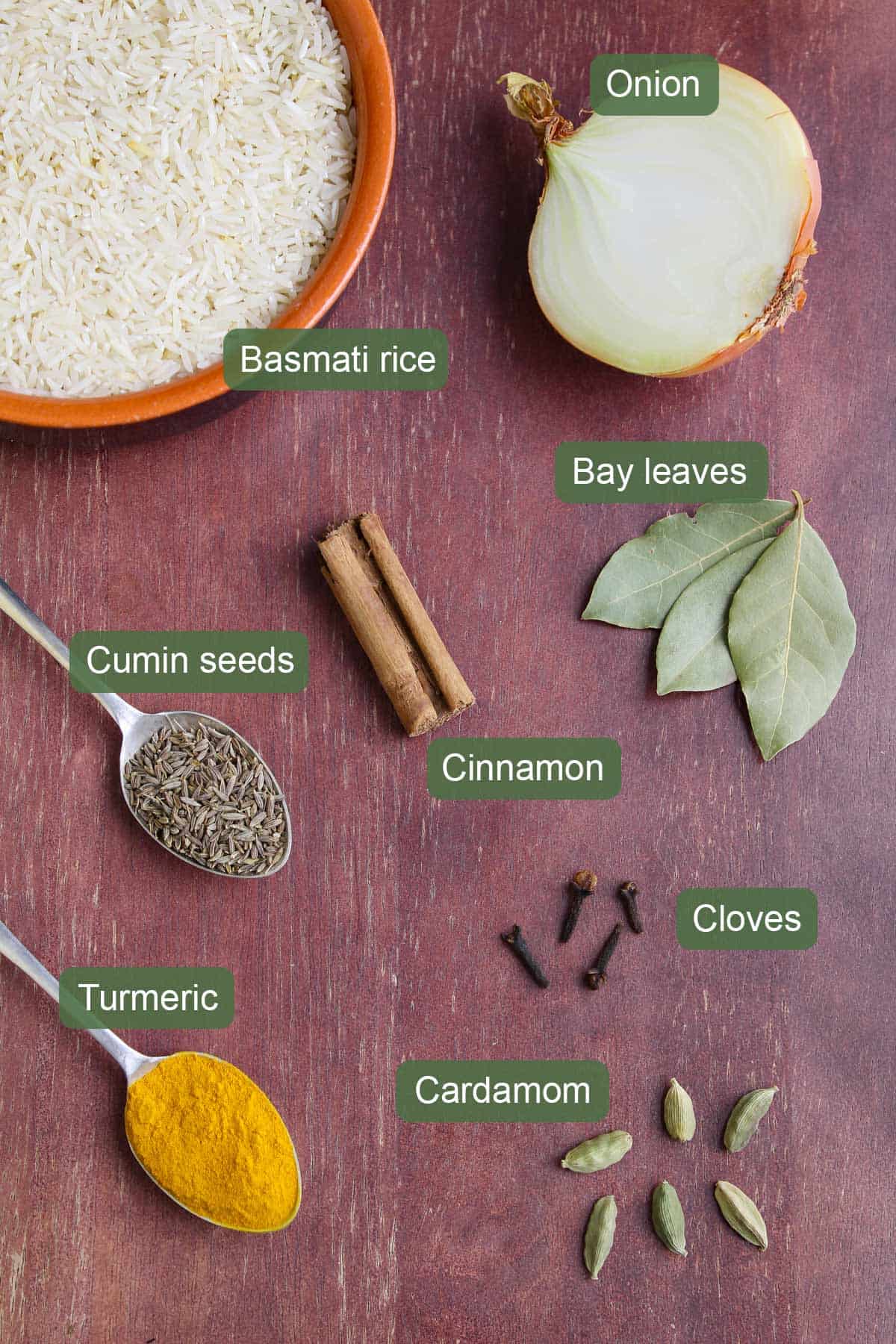
How to make pilau rice
Using a large pan with a tight-fitting lid, heat the oil on a low-medium heat. Add the chopped onion and cook for 7-8 minutes or until starting to turn soft and translucent, but not brown.
Once the onion is soft, add the cumin seeds, cloves, cinnamon stick, turmeric, bay leaves, and salt. Bash the cardamom pods gently with the side of a knife and add these to the pan. Mix everything well and cook for another 2 minutes.
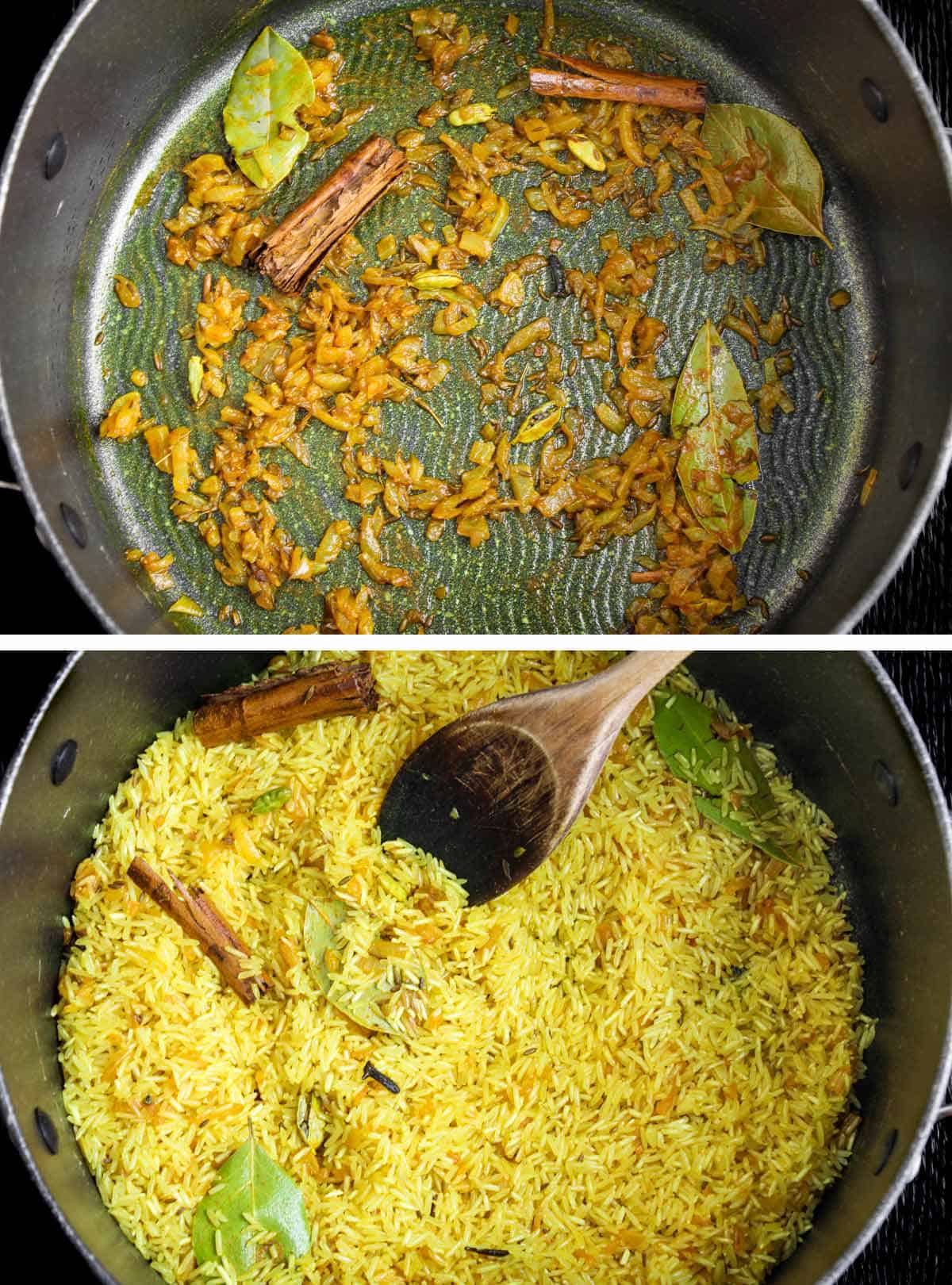
After 2 minutes, add the rice to the pan. Stir well for a minute or so to coat each grain in the mix of oil, onions, and spices.
Next, add the boiling water or vegan stock. Stir everything once, bring back to the boil, then cover with a tight-fitting lid. Reduce the heat to very low and cook for 12 minutes.
Top tip: Cut a piece of aluminium cooking foil to sit in between the pan and the lid. This creates an even tighter seal and helps to steam the rice more thoroughly.
Once the lid is on, use a cloth or oven glove to fold the foil that's sticking out down onto the sides of the pan (see below).
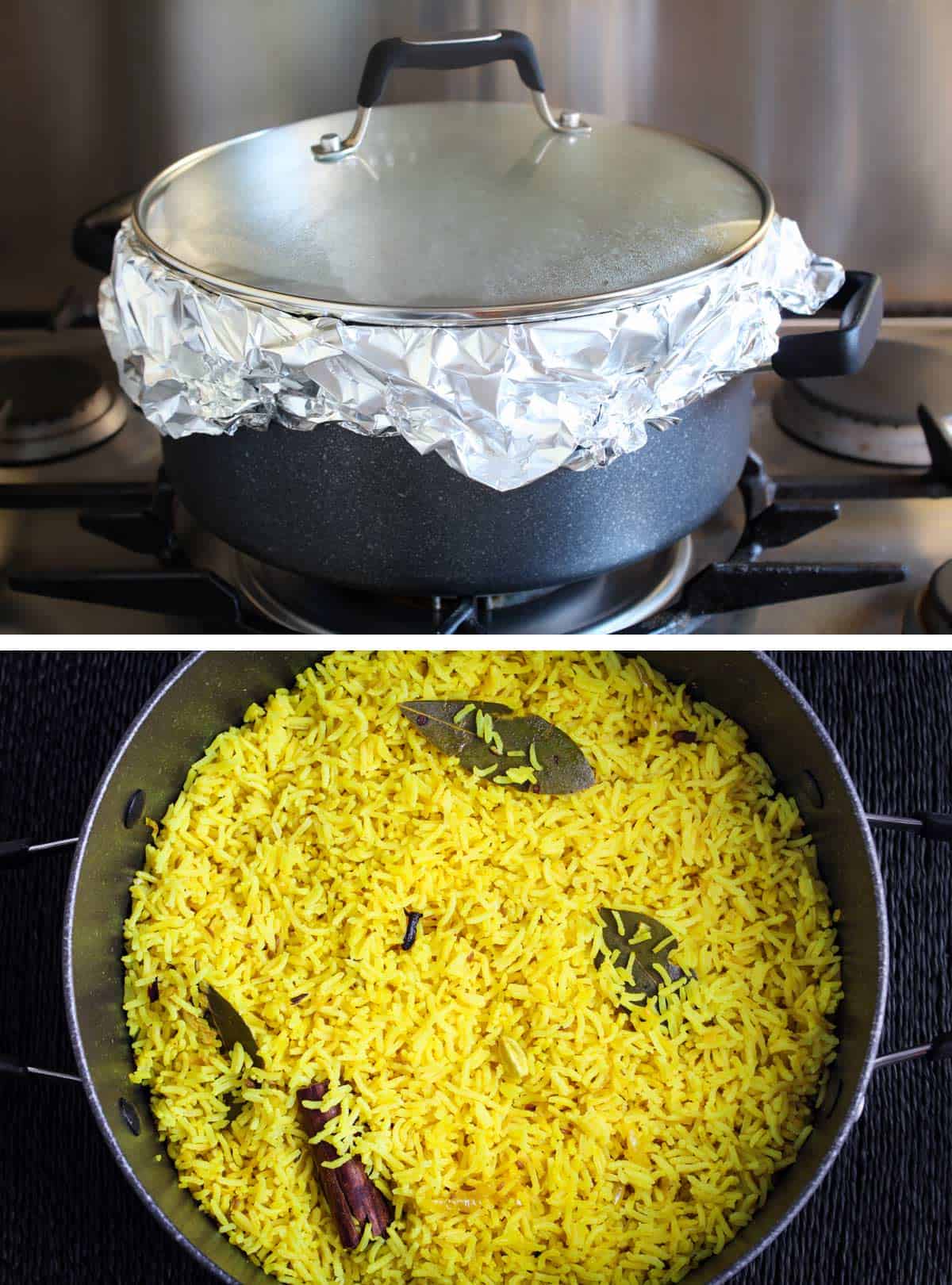
After 12 minutes, the water should all be absorbed. To make sure, you can carefully remove the lid and quickly check (watch out for hot steam escaping). With the water all absorbed, remove from the heat, place the lid back on the pan, and leave to stand for another 5 minutes.
After 5 minutes, remove the lid and discard any whole spices (or just remind people not to eat these). Use a fork to gently fluff up the rice grains and serve.
What to serve with pilau rice
Pilau rice is the perfect accompaniment to your favourite curry dish. If you're looking for inspiration, here are a few of my vegan curry recipes:
- Spicy Tofu Jalfrezi
- Easy Chana Masala (Chickpea Curry)
- Rajma Masala (Kidney Bean Curry)
- Aloo Palak (Potato and Spinach Curry)
- Brinjal Masala (Aubergine Curry)
- Creamy Black Bean Curry
- Vegan Lentil Dal
- Sweet Potato and Lentil Curry
- Creamy Jackfruit Curry
- Chickpea and Cauliflower Coconut Curry
- Chickpea and Green Lentil Curry
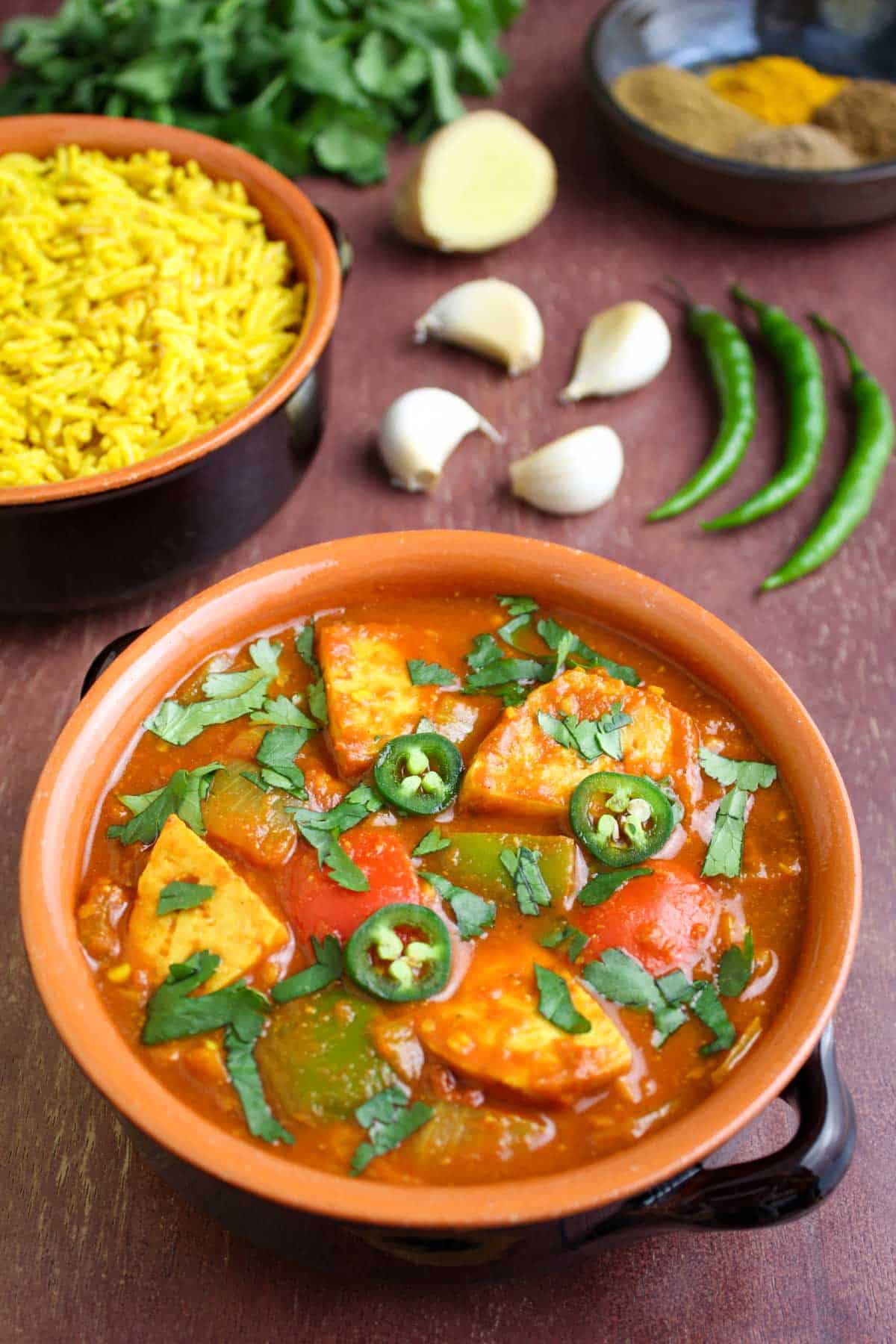
Recipe FAQ
Shop-bought rice has usually been rinsed or cleaned before packing, but there's no harm in rinsing it again to remove any excess starch.
Rice is a naturally gluten-free ingredient. If using vegan stock, you may want to check that this is 100% gluten-free (or just use boiling water).
Store this rice in the fridge in an airtight container for up to four days. Refrigerate as soon as it has cooled down, and don't leave it out at room temperature for too long. Don't reheat more than once.
Yes, you can freeze cooked rice. I'd suggest trying to use it up within one month. Defrost and reheat thoroughly, and don't reheat more than once.
Variations and tips
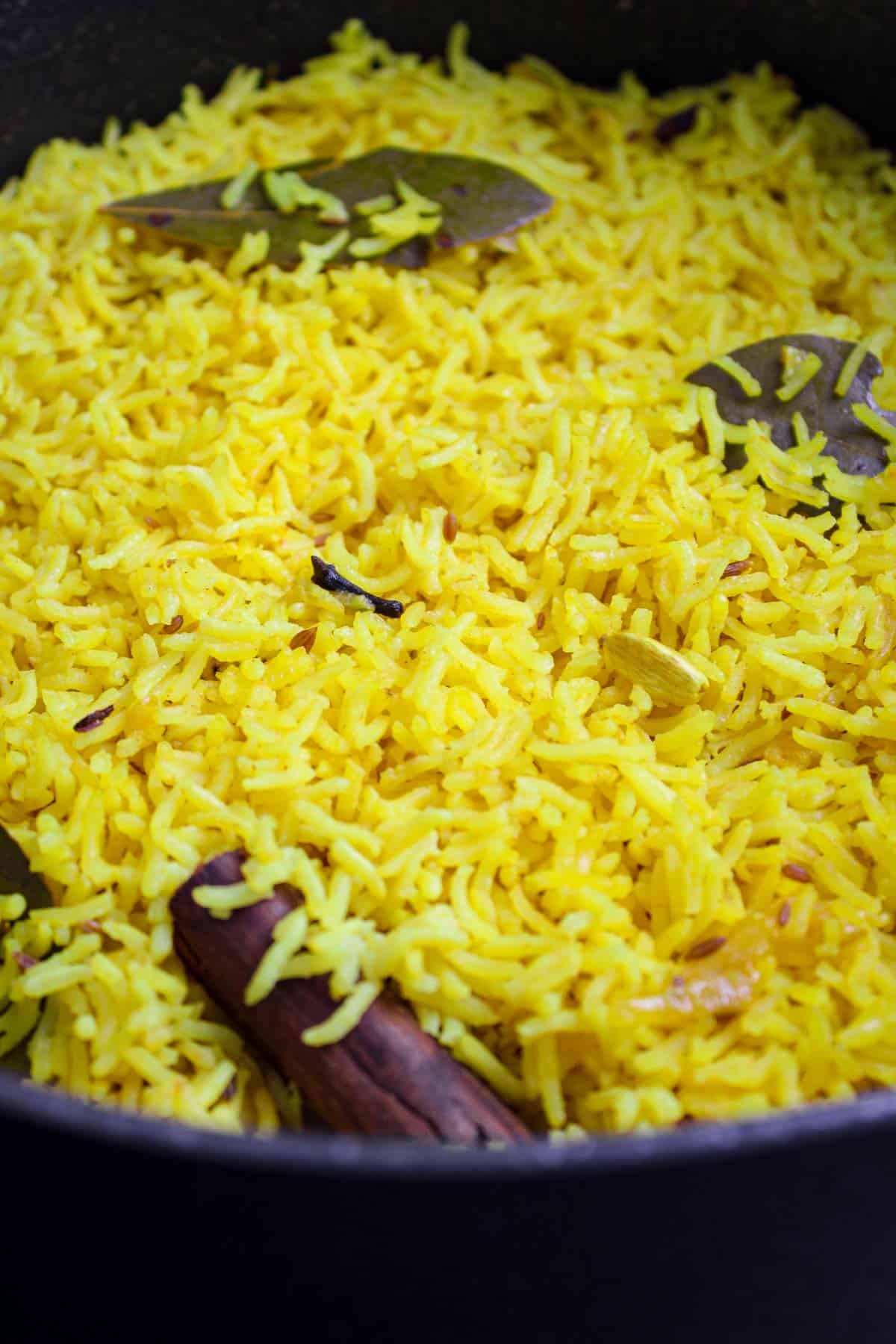
- Rice variety: The best rice to use is dried white basmati rice (not brown rice or an 'easy-cook' variety).
- Other ingredients: Try adding in other ingredients such as green peas, mushrooms, or raisins.
- More aromatics: This recipe is fairly mild so as to not overpower the curry you serve it with, but feel free to add chopped garlic and ginger to the softened onions.
- Whole spices: Biting into a whole clove or cardamom pod is not the most pleasant experience – you can either remove these after cooking or remind people not to eat them.
- Larger batches: If you scale up the amounts, note that the cooking time may need to increase slightly.
Keep in touch
Subscribe below to receive a weekly newsletter with my latest recipes. Nice and simple. No pesky pestering. No spam (which wouldn’t be very vegan anyway).
More vegan recipe ideas
If you liked this recipe, you may also enjoy:
- Moroccan Couscous with Chickpeas and Roasted Veg
- Vegan Rice Noodle Salad
- Crispy Roast Potatoes
- Smoky Bulgur Pilav
- Crispy Smoky Roasted Chickpeas
- Cajun-Spiced Potato Wedges
- Vegan Rice Paper Rolls
- Crispy Baked Falafel
You can also check out my full list of vegan side dishes.
Full recipe
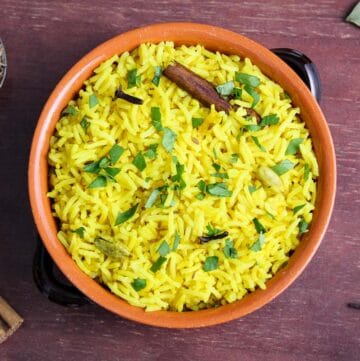
Pilau Rice Recipe
Ingredients
- 3 tablespoons vegetable oil (or other cooking oil)
- 1 medium onion, finely chopped
- 1 teaspoon cumin seeds
- 4 whole cloves
- Small cinnamon stick (approx. 2 inches, or ½ teaspoon ground)
- 1½ teaspoons turmeric
- 3 bay leaves
- ½ teaspoon salt
- 6 cardamom pods
- 2 cups (360 g) dried basmati rice
- 3½ cups (840 ml) boiled water or vegan stock (see recipe notes for getting the ratio just right)
Instructions
- Using a large pan with a tight-fitting lid, heat the oil on a low-medium heat. Add the chopped onion and cook for 7-8 minutes or until starting to turn soft and translucent, but not brown.
- Once the onion is soft, add the cumin seeds, cloves, cinnamon stick, turmeric, bay leaves, and salt. Bash the cardamom pods gently with the side of a knife and add these to the pan. Mix everything well and cook for another 2 minutes.
- After 2 minutes, add the rice to the pan. Stir well for a minute or so to coat each grain in the mix of oil, onions, and spices.
- Next, add the boiling water or vegan stock. Stir everything once, bring back to the boil, then cover with a tight-fitting lid. Reduce the heat to very low and cook for 12 minutes.Top tip: Cut a piece of aluminium cooking foil to sit in between the pan and the lid. This creates an even tighter seal and helps to steam the rice more thoroughly. Once the lid is on, use a cloth or oven glove to fold the foil that's sticking out down onto the sides of the pan (see photo in main post above).
- After 12 minutes, the water should all be absorbed. To make sure, you can carefully remove the lid and quickly check (watch out for hot steam escaping). With the water all absorbed, remove from the heat, place the lid back on the pan, and leave to stand for another 5 minutes.
- After 5 minutes, remove the lid and discard any whole spices (or just remind people not to eat these). Use a fork to gently fluff up the rice grains and serve with your favourite curry. If you're looking for inspiration, check out my recipes for spicy tofu jalfrezi, rajma masala, and chana masala.
Notes
- Vegan Chickpea Biryani
- Moroccan Couscous with Chickpeas and Roasted Veg
- Roasted Cauliflower with Cumin Seeds
- Cajun-Spiced Potato Wedges
- Crispy Smoky Roasted Chickpeas
- Vegan Rice Paper Rolls
- Mushroom Biryani with Lentils
Nutrition
Social follow
🌱 Follow along @thepeskyvegan on Instagram, Pinterest, and Facebook.
Further reading
📩 Fancy keeping in touch? Subscribe to my weekly newsletter.
📖 Find out more about my story.
🍽️ Want to get straight to the food? Hop aboard the recipe train.
🌿 Got a question about veganism? You might find the answer in these vegan FAQs.


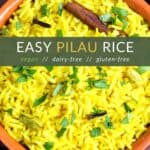
Vicky
Tasty and simple! Thanks 😊
The Pesky Vegan
Cheers!
Alan
Great recipe and easy to follow, will be making again with our next curry. Thanks.
The Pesky Vegan
Good stuff, cheers for the review!